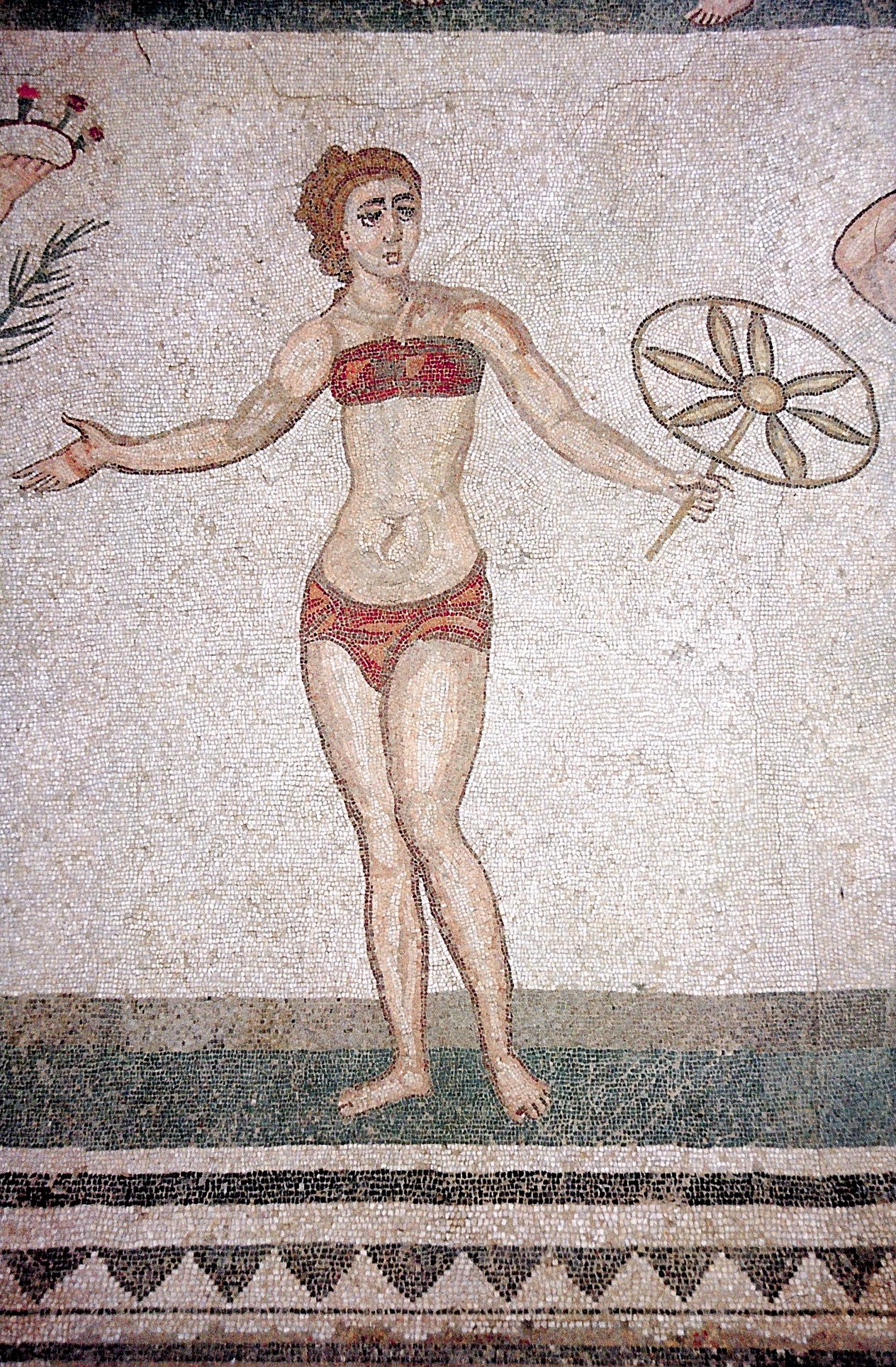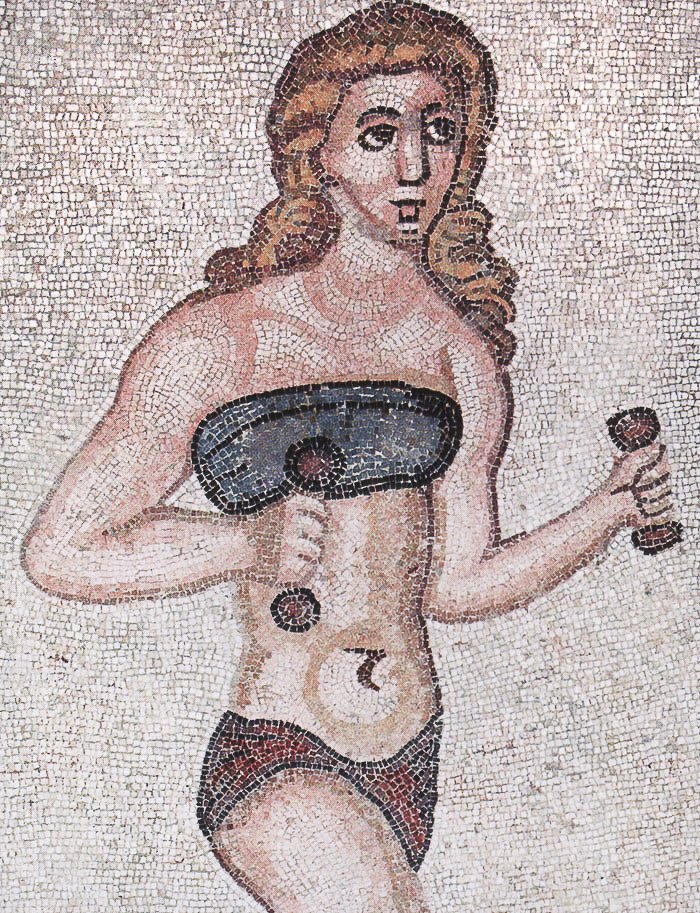BIKINI KILL
Detail of the Coronation of the Winner floor mosaic in the Chamber of the Ten Maidens • 4th Century A.D. • Sala delle Dieci Ragazze • Villa Romana del Casale • Piazza Armerina, Sicily
How Marquis Emilio Pucci paid tribute to his Sicilian roots by having his models debut his bikinis atop the very mosaics that inspired them at the Villa Romana del Casale, a Roman villa built in the first quarter of the fourth century in Sicily.
Model wearing a bikini designed by Emilio Pucci atop ancient mosaics • Spring / Summer 1955 Siciliana Collection • Villa Romana del Casale, Sicily • Elsa Haertter • Image courtesy of the Emilio Pucci Archive
An Emilio Pucci bikini modeled on location atop one of the cherished mosaics at the Roman Villa del Casale • In the mid fifties, Marquis Emilio Pucci designed a collection inspired by the architecture and traditions of Sicily. The name of the collection was fittingly called ‘Siciliana,’ and was one of many the Italian designer dedicated to the beauties and peculiarities of his homeland. Naturally, Pucci and German photographer Elsa Haertter decided to shoot the collection amidst the ancient mosaics at the Villa Romana del Casale. The chosen mosaics appropriately depict a group of female Roman athletes wearing bikini-like ensembles, though these Ancient Roman looks were clearly intended as sportswear, as opposed to swimwear.
The Coronation of the Winner floor mosaic in the Chamber of the Ten Maidens • 4th Century A.D. • Sala delle Dieci Ragazze • Villa Romana del Casale • Piazza Armerina, Sicily
“Located just three kilometres from the Sicilian town of Piazza Armerina, are the extensive remains of a large Roman villa called the Villa Romana del Casale. Dating to the early fourth century AD, it contains one of the single largest collections of ancient Roman mosaics anywhere. One of the many encapsulating mosaics features females in what appear to be modern day bikinis. The room which is home to this particular mosaic is referred to as the Sala delle Dieci Ragazze or ‘Room of the Ten Girls.’ Of the ten women depicted in the mosaic, nine wear what look like two-piece bathing suits. The so–called bikini was essentially a combination of a subligaculum, essentially a loincloth made of cloth or leather and a breastband often made of linen, which the Romans referred to as a strophium. Such articles of clothing were worn by women who engaged in sports or otherwise had an active lifestyle.” • Courtesy of Italian Ways
Model wearing a bikini designed by Emilio Pucci atop ancient mosaics • Spring / Summer 1955 Siciliana Collection • Villa Romana del Casale, Sicily • Elsa Haertter • Image courtesy of the Emilio Pucci Archive
Detail of the Coronation of the Winner floor mosaic in the Chamber of the Ten Maidens • 4th Century A.D. • Sala delle Dieci Ragazze • Villa Romana del Casale • Piazza Armerina, Sicily
Detail of the Coronation of the Winner floor mosaic in the Chamber of the Ten Maidens • 4th Century A.D. • Sala delle Dieci Ragazze • Villa Romana del Casale • Piazza Armerina, Sicily
Model wearing a bikini designed by Emilio Pucci atop ancient mosaics • Spring / Summer 1955 Siciliana Collection • Villa Romana del Casale, Sicily • Elsa Haertter • Image courtesy of the Emilio Pucci Archive
Detail of the Coronation of the Winner floor mosaic in the Chamber of the Ten Maidens • 4th Century A.D. • Sala delle Dieci Ragazze • Villa Romana del Casale • Piazza Armerina, Sicily
The Coronation of the Winner floor mosaic in the Chamber of the Ten Maidens • 4th Century A.D. • Sala delle Dieci Ragazze • Villa Romana del Casale • Piazza Armerina, Sicily
Model wearing a bikini designed by Emilio Pucci atop ancient mosaics • Spring / Summer 1955 Siciliana Collection • Villa Romana del Casale, Sicily • Elsa Haertter • Image courtesy of the Emilio Pucci Archive via Pucci by Vanessa Friedman
The Coronation of the Winner floor mosaic in the Chamber of the Ten Maidens • 4th Century A.D. • Sala delle Dieci Ragazze • Villa Romana del Casale • Piazza Armerina, Sicily
Detail of the Coronation of the Winner floor mosaic in the Chamber of the Ten Maidens • 4th Century A.D. • Sala delle Dieci Ragazze • Villa Romana del Casale • Piazza Armerina, Sicily












